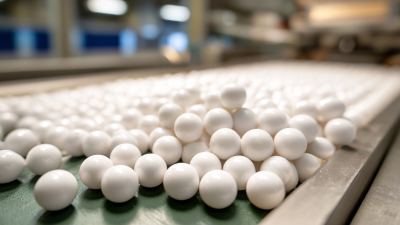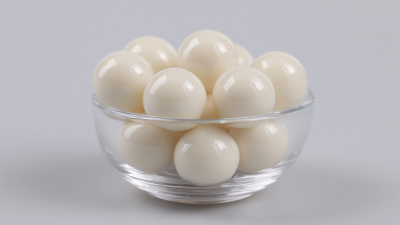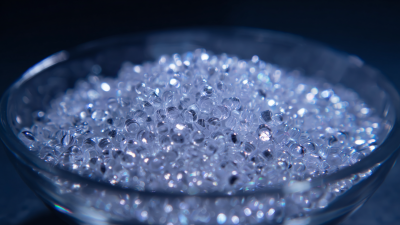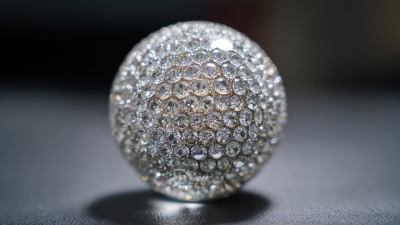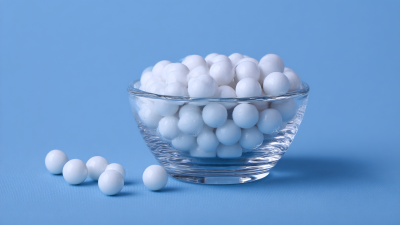In recent years, the Zirconia Silicate Ball has emerged as a pivotal component in various modern industries and manufacturing processes. Its unique composition and exceptional properties, such as high wear resistance and thermal stability, make it an ideal choice for applications ranging from grinding and milling to advanced coatings and ceramics. As businesses seek innovative solutions to enhance productivity and product quality, understanding the potential of Zirconia Silicate Balls becomes essential.
This article delves into the characteristics that make Zirconia Silicate Balls stand out among other materials used in industrial applications. We will explore their manufacturing processes, the science behind their superior performance, and the diverse industries that benefit from their usage. By unlocking the secrets of this remarkable material, industries can harness its full potential to drive efficiency, reduce costs, and improve overall output quality. As we embark on this exploration, we aim to highlight the significant role that Zirconia Silicate Balls play in shaping the future of manufacturing and industry.

Zirconia silicate balls have emerged as a critical component in modern manufacturing due to their unique properties, making them invaluable in various industrial applications. One of the standout characteristics of these balls is their exceptional hardness and resistance to wear, which significantly enhances the durability of machinery and processes. This hardness allows zirconia silicate balls to withstand significant mechanical stress, making them ideal for use in milling and grinding operations, where longevity and performance are paramount.
Additionally, zirconia silicate balls exhibit remarkable chemical stability and thermal resistance. This property ensures that they can be utilized in environments that involve harsh chemicals or extreme temperatures without degrading. Their low density also contributes to efficient energy use in manufacturing processes, as lighter materials require less force to move and can improve overall efficiency. As industries strive for enhanced performance and sustainability, the integration of zirconia silicate balls into various applications highlights their role in driving innovation and productivity across modern manufacturing sectors.
Zirconia silicate balls have emerged as versatile materials in various industries owing to their remarkable properties such as high wear resistance, low thermal conductivity, and chemical stability. In the ceramics industry, these balls are widely used in grinding and milling applications to achieve fine particle sizes. Their use enhances the durability of machinery while ensuring that the quality of the end product remains uncompromised. This unique material is also employed in the manufacturing of advanced materials, providing excellent support in formulations needing precise particle distribution.
Tips: When using zirconia silicate balls, ensure to match the size and density of the balls with the materials being processed for optimal grinding efficiency. Regularly check the integrity of the balls to prevent contamination of the mixture.
In addition to ceramics, zirconia silicate balls find applications in the electronics sector, specifically in the production of semiconductors. Their thermal resistance and electrical insulation properties make them ideal for components that operate under extreme conditions. Furthermore, in the pharmaceutical industry, these balls are utilized for milling active ingredients, thus facilitating the production of high-purity substances essential for drug formulation.
Tips: Always store zirconia silicate balls in a controlled environment to prevent moisture absorption, which can affect their performance during milling processes.
Zirconia silicate balls have emerged as a preferred material in various industrial applications, particularly when compared to traditional options like ceramic or steel balls. Their unique composition offers superior performance characteristics, such as enhanced hardness and wear resistance. This makes zirconia silicate balls especially valuable in processes that require high durability and precision, such as milling and grinding. Traditional materials often suffer from limitations in strength and longevity, leading to higher maintenance costs and downtime in production.
Furthermore, the comparative analysis highlights the significant benefits zirconia silicate balls hold over conventional materials in terms of chemical resistance and reduced contamination. While materials like steel can corrode or react adversely in certain environments, zirconia silicate balls demonstrate exceptional stability even in harsh conditions. This property not only improves the quality of the final product but also extends the lifespan of the equipment used. As industries evolve and demand increasingly precise and resilient materials, zirconia silicate balls stand out as an innovative alternative that meets the rigorous demands of modern manufacturing processes.
The economic benefits of using zirconia silicate balls in production processes are substantial, primarily due to their exceptional durability and efficiency. These balls are engineered to withstand high levels of stress and wear, significantly reducing maintenance costs and downtime in manufacturing operations. Their resistance to chemical reactions makes them suitable for various environments, further broadening their applicability across industries such as ceramics, paints, and automotive.
Additionally, the use of zirconia silicate balls enhances product quality and consistency. These balls facilitate more efficient particle size reduction and mixing, leading to superior outcomes in the final product. As manufacturers increasingly focus on sustainability and cost-effectiveness, the integration of zirconia silicate balls into production processes not only promotes environmental responsibility by minimizing waste but also increases overall operational efficiency. This combination of performance and economic advantage makes zirconia silicate balls a valuable asset in modern industrial applications.
Zirconia silicate balls continue to gain momentum across various industries, driven by advancements in technology and increasing demand for high-performance materials. In the realm of dentistry, the zirconia-based dental materials market is projected to experience significant growth, reaching approximately USD 902.42 million by 2034. This growth is fueled by the material’s superior properties such as biocompatibility, strength, and aesthetics, making it a preferred choice for crowns and dental implants.
As companies innovate in manufacturing techniques, ceramic additive manufacturing is at the forefront, enhancing the production of zirconia components. The integration of digital technologies within this sector is paving the way for more efficient processes and designs tailored to specific industrial applications.
Tips: When considering the implementation of zirconia silicate balls in manufacturing, focus on material quality and sourcing to ensure optimal performance. Additionally, stay updated on emerging technologies that could further enhance production efficiency and product durability. Collaborating with research institutions could also provide insights into cutting-edge developments in zirconia-based materials, keeping your operations competitive.
